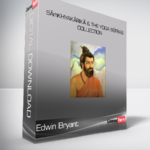Edwin Bryant – Sāṁkhyakārikā & The Yoga Sūtras – Collection
Original price was: $149.00.$64.00Current price is: $64.00.
Explore metaphysical contours of Yoga and Sāṁkhya. Gain insight into the nature of mind and self.
File Size: 9.76 GB.
- Description
- Reviews (0)
Description
Edwin Bryant – Sāṁkhyakārikā & The Yoga Sūtras – Collection

Engage a primary canonical text within the larger metaphysical tradition of Yoga . . .
Explore the Foundations of Yoga Philosophy
This course offers the unique opportunity to . . .
. . . delve into ancient texts shaping Yoga’s philosophical landscape
. . . bridge foundational wisdom with contemporary spiritual practices
. . . understand dualistic metaphysics through comparative textual analysis
. . . explore existential themes of liberation and human suffering
This 8-part course will undertake a comparative study of two canonical texts of Yoga: the Sāṁkhyakārikā & the Yoga Sūtras. In the earlier tradition, Yoga is in fact an expression of Sāṁkhya rather than a distinct school, the former focusing more on meditational practice and the latter on metaphysics. Using the Kārikās as our primary text, along with its principle commentary by Gauḍapāda, we will consider where the two texts overlap, and where the Kārikās engage material not touched upon in the Yoga Sūtras.
We will read all of the Kārikās, and cast comparative glances at the sections of the Sūtras that express the same concepts albeit sometimes in different terminologies. Mainkar’s translation of the Kārikās and Gauḍapāda’s bhāṣya will be provided; students are requested to bring any copy of the Yoga Sūtras with the Sanskrit text.
Students of this course will learn to:
- Interpret philosophical concepts from the Sāṁkhyakārikā and Yoga Sūtras.
- Understand the dualistic nature of Prakṛti and Puruṣa.
- Analyze the three Guṇas and their influence on reality.
- Compare and contrast the metaphysical views of Sāṁkhya and Yoga.
- Recognize the pathways to liberation as outlined in the texts.
- Explore the interaction between consciousness and the material world.
- Apply ancient teachings to modern-day spiritual inquiries.
- Develop an understanding of mental states and their transformations.
Course Outline
MODULE 1: Reasons for Seeking Liberation
In this section, we engage the essential motive for undertaking the spiritual quest in the respective traditions of Yoga and Sāṁkhya, namely suffering. The causes of suffering according to these two traditions will be examined, and the solution considered – liberation (kaivalya), along with the respective means to attain. While the two traditions share the former aspects and presuppositions in common, it is in the latter regard – the means to attain liberation, that they part company and eventually form different schools. Kārikās 1 – 5 Yoga Sūtras 1-6; 1.49; II.12-15; II.19; II.225-6
MODULE 2: The Nature of Prakṛti and Puruṣa
The metaphysics of Sāṁkhya and Yoga are essentially dualistic: there are two ontologically distinct entities, prakṛti and puruṣa, or the conscious self and unconscious matter. This session explores what our two canonical texts have to say about how these two diametrically distinct sorts of things can be described in conceptual terms. Kārikās 6 – 10 Yoga Sūtras II. 17 – 24
MODULE 3: The Three Guṇas
Following on the previous lecture, the world of matter, prakṛti, is essentially composed of three ‘qualities,’ the guṇas of Sāṁkhya – sattva, rajas and tamas. The respective nature of these three guṇas are discussed here, bolstered by some verses from the Bhagavad Gītā, which is also a Sāṁkhya text, and an excellent source for more specific information on the guñas’ role in everyday matters. Kārikās 11 – 14 Yoga Sütras II.18
MODULE 4 : Properties of Prakṛti and Puruṣa
This session continues with the previous discussions on the respective nature of the two ultimate metaphysical entities of reality – prakṛti and puruṣa. Kārikās 15 – 21 Yoga Sūtras II.18 – II.26
MODULE 5 : Evolutes of Prakṛti
Sāṁkhya is a metaphysically evolutionist system, in so far as gross entities such as particles are densifications of subtler energies, which in turn are emanations from still subtler energies, and on back to the subtlest matrix of all, prakṛti herself. In this session, we gain some sense of this metaphysics. Kārikās 22 – 37 Yoga Sūtras II.19
MODULE 6 : The Subtle Body
This session engages the nature of the subtle body, also made of prakṛtic ‘stuff’ (albeit finer more sattvic stuff), which acts as the interface between puruṣa, consciousness, and the ‘world out there.’ Kārikās 38 – 42 Yoga Sütras II.18
MODULE 7 : The Nature of Mind
This session engages how the various aspects of the mind and its mental states are differently characterized in the two systems – the vṛttis and kleṣas of yoga, and the bhāvas of Sāṁkhya. Kārikās 43-54 Yoga Sūtras I.5-13; II.3-9; II.15-18
MODULE 8 : Liberation from Embodiment
The grand finale goal of both traditions is liberation from embodiment itself, which is the only way to ultimately be free of all suffering. This session explores how liberation is depicted in our two texts. Here we encounter some of the most beautiful verses of the Sāṁkhyakārikās. Kārikās 55 – 72 Yoga Sūtras II.23 – 28; IV29 – 34
Join us for an enriching journey through the core teachings and transformative wisdom of two pivotal spiritual texts, unlocking pathways to deeper self-awareness and spiritual liberation.
Get Digital Download ” Edwin Bryant – Sāṁkhyakārikā & The Yoga Sūtras – Collection ” Right Now!




Reviews
There are no reviews yet.